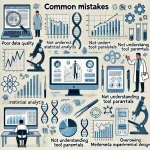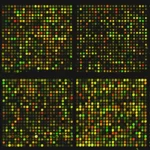
What is the difference between bioinformatics and computational biology?
November 23, 2023I. Introduction
A. Definition of Bioinformatics
Bioinformatics is an interdisciplinary field that combines biology, computer science, and information technology to analyze and interpret biological data. It involves the development and application of computational tools and techniques to organize, manage, and analyze large sets of biological information, such as DNA sequences, protein structures, and metabolic pathways.
B. Definition of Computational Biology
Computational Biology is a branch of biology that uses mathematical and computational techniques to model and analyze biological systems. It encompasses a wide range of approaches, including the development of algorithms for data analysis, computational modeling of biological processes, and the simulation of complex biological systems.
C. Overview of the Relationship between Bioinformatics and Computational Biology
Bioinformatics and Computational Biology are closely related fields, often used interchangeably. Bioinformatics primarily focuses on the development of tools and databases to organize and retrieve biological information, while Computational Biology involves using computational methods to model and understand biological processes. Together, these fields play a crucial role in advancing biological research by providing innovative solutions to analyze and interpret the ever-growing volume of biological data. The synergy between bioinformatics and computational biology contributes to a deeper understanding of biological phenomena and the development of new hypotheses and discoveries.
II. Scope and Focus
A. Bioinformatics
- Emphasis on Data Management and Analysis: Bioinformatics primarily emphasizes the development of tools and techniques for the management, organization, and analysis of biological data. This includes the creation of databases, algorithms for data retrieval, and statistical methods for analyzing biological information.
- Application in Biological Research and Molecular Biology: The primary application of bioinformatics is in biological research and molecular biology. It plays a crucial role in tasks such as DNA sequence analysis, protein structure prediction, and functional genomics. Bioinformatics tools aid researchers in extracting meaningful insights from vast biological datasets.
B. Computational Biology
- Focus on Developing Algorithms and Models: Computational Biology has a broader focus that includes the development of algorithms and computational models to understand and simulate biological processes. It involves the creation of mathematical models to represent biological phenomena, allowing for simulations and predictions.
- Broader Scope Including Theoretical and Algorithmic Aspects: Computational Biology encompasses theoretical and algorithmic aspects, extending beyond data analysis. It involves the development of mathematical models to describe biological systems, algorithms for simulating biological processes, and computational approaches to understanding complex biological phenomena.
In summary, while bioinformatics is primarily concerned with the practical aspects of managing and analyzing biological data, computational biology has a broader scope that includes theoretical and algorithmic contributions to understanding and modeling complex biological systems. Together, these fields synergize to contribute to advancements in biological research and computational modeling.
III. Data Handling and Analysis
A. Bioinformatics
- Managing and Analyzing Biological Data: Bioinformatics focuses on the effective management and analysis of biological data. This includes the organization, storage, retrieval, and interpretation of large datasets generated in various biological experiments. Bioinformatics tools and databases play a crucial role in extracting meaningful information from biological information.
- Utilizing Databases, Tools, and Statistical Methods: In bioinformatics, the emphasis is on leveraging databases, computational tools, and statistical methods to process and analyze biological data. This involves the use of bioinformatics software and algorithms for tasks such as sequence alignment, structural prediction, and functional annotation.
B. Computational Biology
- Developing Algorithms for Data Analysis: Computational Biology involves the development of algorithms specifically tailored for the analysis of biological data. These algorithms are designed to extract patterns, relationships, and insights from complex datasets. Computational biologists create novel computational methods to address specific challenges in data analysis.
- Creating Computational Models to Understand Biological Processes: In computational biology, researchers focus on creating computational models that represent and simulate biological processes. These models may involve mathematical representations of biological phenomena, allowing for simulations and predictions. Computational biology contributes to a deeper understanding of the underlying mechanisms governing biological systems.
In essence, while bioinformatics concentrates on the practical aspects of handling and analyzing biological data using existing tools and databases, computational biology involves the development of new algorithms and models to advance our understanding of complex biological processes. Together, they form a comprehensive approach to extracting knowledge from biological information.
IV. Interdisciplinary Nature
A. Bioinformatics
- Integration of Biology, Computer Science, and Information Technology: Bioinformatics is inherently interdisciplinary, bringing together principles from biology, computer science, and information technology. It involves the application of computational methods to process and analyze biological data. This interdisciplinary approach enables the development of tools and databases that support biological research.
- Collaborations with Domain Experts for Data Interpretation: Bioinformatics professionals often collaborate closely with domain experts in biology and related fields. This collaboration is essential for interpreting the results of bioinformatics analyses in a biologically meaningful context. Effective communication between bioinformaticians and biologists ensures that computational findings align with the biological understanding of the systems under study.
B. Computational Biology
- Involvement of Computational and Mathematical Methods: Computational Biology embraces computational and mathematical methods to create models and algorithms for understanding biological processes. This interdisciplinary field relies on the application of quantitative and computational approaches to analyze complex biological data. It involves the development of computational tools to simulate and predict biological phenomena.
- Collaborations with Biologists for Theoretical Modeling: Computational biologists collaborate with biologists to create theoretical models that represent biological systems. These models are often based on mathematical equations and computational simulations. The collaborative effort ensures that the computational models align with the empirical knowledge of biologists, leading to more accurate representations of biological phenomena.
The interdisciplinary nature of both bioinformatics and computational biology is a key strength, allowing researchers to leverage expertise from multiple domains. While bioinformatics focuses on the practical aspects of data management and analysis, computational biology contributes to the theoretical modeling and simulation of biological processes. Together, they provide a comprehensive approach to advancing our understanding of the complexities within the realm of biology.
V. Applications
A. Bioinformatics
- Genomic Data Analysis: Bioinformatics plays a crucial role in the analysis of genomic data, including DNA sequences, gene expression profiles, and variations. It involves the development and application of computational tools to interpret the vast amount of genomic information generated through technologies like high-throughput sequencing.
- Protein Structure Prediction: Bioinformatics contributes to predicting the three-dimensional structures of proteins. Through computational methods, bioinformaticians can analyze amino acid sequences and predict the folding patterns and structural characteristics of proteins. This information is vital for understanding protein function and interactions.
- Functional Annotation of Genes: Bioinformatics tools are employed to annotate and predict the functions of genes. This includes identifying protein-coding regions, regulatory elements, and assigning biological functions to genes based on sequence analysis. Functional annotation is essential for deciphering the roles of genes in various biological processes.
B. Computational Biology
- Algorithm Development for Sequence Analysis: Computational biology focuses on the development of algorithms for the analysis of biological sequences, such as DNA, RNA, and proteins. These algorithms enable tasks like sequence alignment, motif discovery, and phylogenetic analysis, providing insights into evolutionary relationships and functional elements.
- Mathematical Modeling of Biological Processes: Computational biologists create mathematical models to represent and simulate biological processes. These models help in understanding the dynamics of complex biological systems, including cell signaling, metabolic pathways, and gene regulatory networks. Mathematical modeling aids in predicting system behaviors and testing hypotheses.
- Systems Biology Simulations: Computational biology contributes to the field of systems biology by simulating the interactions and behaviors of biological components within a system. Computational models integrate data from various omics levels to simulate how genes, proteins, and metabolites interact, providing a holistic view of biological processes.
The applications of both bioinformatics and computational biology are integral to advancing biological research and leveraging computational tools to extract meaningful insights from diverse biological data types. While bioinformatics focuses on data analysis and interpretation, computational biology emphasizes algorithmic development and mathematical modeling for a deeper understanding of biological phenomena.
VI. Tools and Techniques
A. Bioinformatics
- Utilization of Existing Databases and Tools: In bioinformatics, researchers leverage a variety of existing databases and tools to store, retrieve, and analyze biological data. Databases like GenBank, UniProt, and tools like BLAST (Basic Local Alignment Search Tool) are widely used for tasks such as sequence alignment, annotation, and functional analysis.
- Application of Statistical Methods for Data Interpretation: Statistical methods play a crucial role in bioinformatics for extracting meaningful insights from biological data. Techniques such as hypothesis testing, regression analysis, and machine learning are applied to analyze experimental results, identify patterns, and make predictions based on biological datasets.
B. Computational Biology
- Development of New Algorithms and Software: Computational biology involves the creation of novel algorithms and software tools to address specific challenges in biological data analysis. This includes algorithms for sequence alignment, structural prediction, and network analysis. The development of computational tools is essential for advancing the field and improving the accuracy and efficiency of analyses.
- Mathematical and Computational Modeling Techniques: Computational biologists use mathematical models to represent biological processes and phenomena. This includes differential equations, agent-based modeling, and other mathematical techniques. By integrating experimental data into these models, researchers can simulate and predict the behavior of complex biological systems under different conditions.
Both bioinformatics and computational biology rely on a combination of established tools and techniques as well as the development of new methods to address evolving research questions. The utilization of databases, tools, statistical methods, algorithms, and modeling techniques collectively contributes to the advancement of our understanding of biological systems.
VII. Educational Background
A. Bioinformatics
- Emphasis on Biological Sciences with Computational Skills: Bioinformatics programs typically emphasize a solid foundation in biological sciences combined with proficiency in computational skills. Students gain knowledge in genetics, molecular biology, and biochemistry alongside learning programming languages, data analysis, and database management.
- Programs Often Offered in Collaboration with Biology Departments: Bioinformatics programs are commonly offered in collaboration with biology or life sciences departments. This interdisciplinary approach ensures that students acquire a comprehensive understanding of biological principles while also developing the computational skills necessary for handling and analyzing large-scale biological data.
B. Computational Biology
- Strong Focus on Computational and Mathematical Methods: Computational biology programs place a strong emphasis on developing computational and mathematical methods for solving biological problems. Students delve into algorithms, machine learning, and quantitative modeling techniques to understand complex biological processes from a computational perspective.
- Programs May Be Offered Within Computer Science or Applied Mathematics Departments: Computational biology programs are often housed within computer science or applied mathematics departments. This reflects the program’s focus on developing advanced computational methodologies and algorithms. Students in these programs gain a deep understanding of computational theory and its applications in biology.
Both educational paths provide students with the necessary skills to contribute to the interdisciplinary field of computational biology and bioinformatics. The distinction lies in the emphasis on biological sciences for bioinformatics and the focus on computational and mathematical methods for computational biology.
VIII. Career Paths
A. Bioinformatics
- Bioinformatician Roles in Research Institutions, Pharmaceutical Companies, and Healthcare: Graduates with a background in bioinformatics find opportunities as bioinformaticians in diverse settings. They contribute to genomics research, drug discovery, and clinical applications. Positions in research institutions, pharmaceutical companies, and healthcare organizations involve utilizing bioinformatics tools for data analysis and interpretation.
- Data Analysis and Curation Positions: Bioinformatics professionals often specialize in data analysis and curation. They play a crucial role in managing and interpreting biological data, ensuring data quality, and curating databases. This includes handling large-scale genomics, transcriptomics, and proteomics datasets, making meaningful interpretations, and maintaining data integrity.
B. Computational Biology
- Computational Biologist Positions in Academia and Research: Computational biology graduates pursue careers as computational biologists in academic institutions and research organizations. They contribute to advancing biological knowledge by developing and applying computational models, algorithms, and simulations. Positions involve collaborating with biologists to address complex biological questions through computational approaches.
- Algorithm Development and Modeling Roles: Computational biology professionals often focus on algorithm development and mathematical modeling. They work on creating innovative algorithms for analyzing biological data, predicting molecular structures, and simulating biological processes. These roles contribute to advancements in computational methods used to understand biological systems.
Both career paths offer exciting opportunities to contribute to cutting-edge research, with bioinformatics professionals specializing in data-driven analysis and computational biology professionals focusing on algorithmic development and modeling. The choice between the two depends on individual interests and the desired contribution to the field.
IX. Future Trends and Integration
A. Advancements in Interdisciplinary Collaboration
- Enhanced Integration of Bioinformatics and Computational Biology: The future will witness a seamless integration of bioinformatics and computational biology, breaking down traditional silos. Collaborations will intensify, with professionals from both domains working together to address complex biological questions. Interdisciplinary teams will become the norm, fostering a holistic approach to research.
- Emergence of Integrated Research Platforms: Expect the development of integrated platforms that combine bioinformatics tools and computational biology models. These platforms will streamline data analysis, algorithm development, and simulations, providing researchers with comprehensive solutions for studying biological systems.
B. Evolving Roles and Skillsets in Both Bioinformatics and Computational Biology
- Expanded Skill Requirements: As technologies advance, professionals in both fields will need to expand their skillsets. Bioinformaticians may delve deeper into algorithm development, while computational biologists might enhance their knowledge of experimental techniques. Cross-training and upskilling will become common to navigate the evolving landscape.
- Hybrid Roles and Integrated Training Programs: The distinction between bioinformatics and computational biology roles may blur, leading to the emergence of hybrid positions. Integrated training programs will equip professionals with a broad skillset that spans both domains. Graduates will possess a versatile skill profile suitable for various research challenges.
- Focus on Data Science Competencies: Proficiency in data science will become increasingly vital for professionals in bioinformatics and computational biology. Skills in machine learning, data visualization, and statistical analysis will be in high demand to extract meaningful insights from complex biological datasets.
- Impact of Emerging Technologies: Anticipate the incorporation of emerging technologies, such as quantum computing and advanced AI, in both bioinformatics and computational biology. These technologies will revolutionize data processing, algorithmic complexity, and the scale of simulations, opening new avenues for exploration.
The future of bioinformatics and computational biology holds exciting prospects, driven by enhanced collaboration, evolving roles, and the integration of cutting-edge technologies. Professionals in these fields can look forward to dynamic career paths that contribute significantly to advancing biological research.
X. Conclusion
A. Recap of Key Differences and Commonalities
In conclusion, the realms of bioinformatics and computational biology, while distinct, share a symbiotic relationship that contributes immensely to the understanding of complex biological systems. Bioinformatics, with its emphasis on data management and analysis, collaborates seamlessly with computational biology, which focuses on developing algorithms and computational models.
Throughout this exploration, we’ve noted key differences, such as the emphasis on data handling in bioinformatics and algorithm development in computational biology. Despite these distinctions, both fields converge on their commitment to advancing biological research through interdisciplinary collaboration and the integration of diverse skillsets.
B. Acknowledgment of the Evolving and Interconnected Nature of Both Fields
As technology advances and biological questions become more intricate, the boundaries between bioinformatics and computational biology continue to evolve. The interconnected nature of these fields is evident in the growing trend of collaborative research, integrated platforms, and hybrid roles that leverage the strengths of both disciplines.
In the ever-expanding landscape of biological sciences, the roles of bioinformaticians and computational biologists are becoming increasingly interconnected and indispensable. Together, they navigate the complexities of biological data, unravel the secrets of molecular processes, and contribute to groundbreaking discoveries that shape the future of life sciences.
As we move forward, the dynamic synergy between bioinformatics and computational biology will play a pivotal role in unraveling the mysteries of life and advancing our understanding of the intricacies within living systems. This interconnected journey is poised to bring forth new insights, methodologies, and technological innovations that will revolutionize the landscape of biological research.Computational models


















